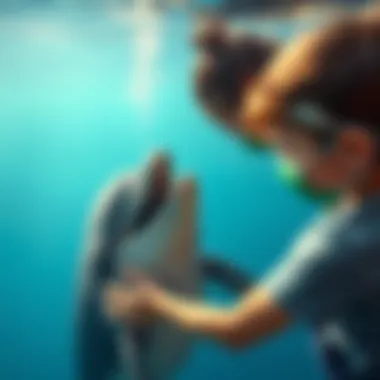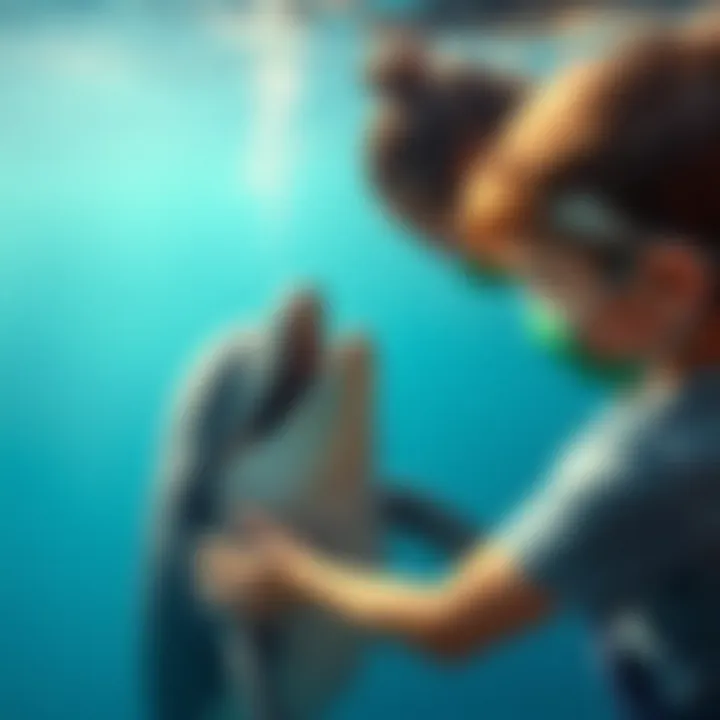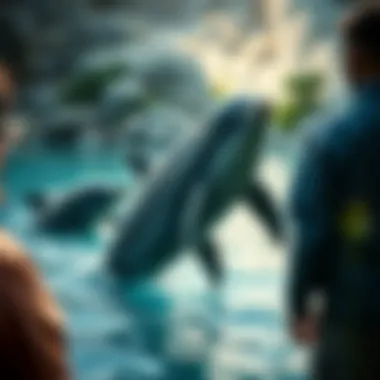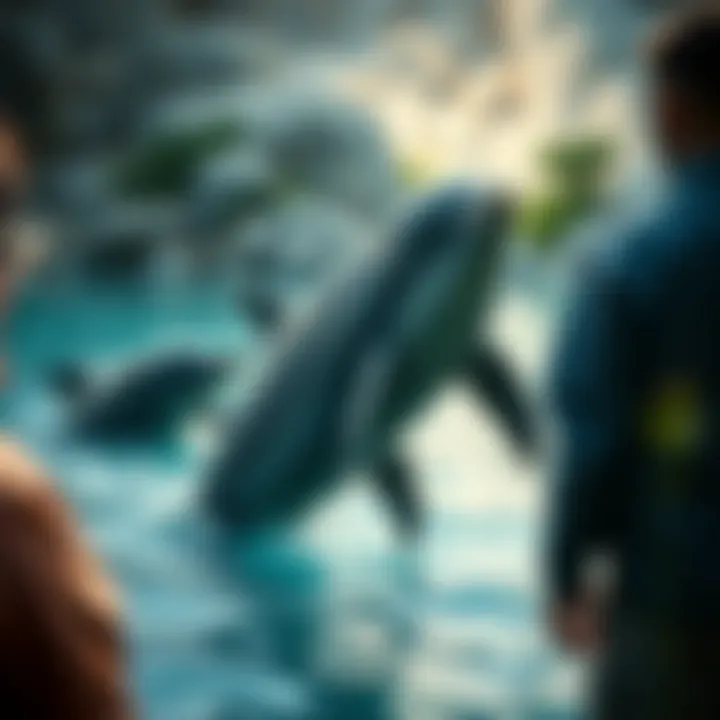Dolphins: Partners in Human Welfare and Research


Intro
Dolphins are more than just creatures of the sea; they have woven themselves into the fabric of human culture and experience in ways that are both profound and diverse. Their playful nature and intelligence often captivate us, but beyond that, these marine mammals hold a significant role in assisting humans, whether through therapeutic means, rescues at sea, or contributions to scientific research. The harmonious interactions between humans and dolphins reveal layers of cognitive, emotional, and social complexities that merit exploration.
This article seeks to dive deep into the multifaceted relationships we share with dolphins, highlighting the ways in which they aid us and the broader implications of these connections. Understanding the essence of dolphins requires an exploration not just of their innate behaviors, but of the environment they inhabit and the challenges they face. By shedding light on their cognitive abilities, we can appreciate their unique contributions to human welfare while recognizing the value of preserving their habitat for future generations.
Key Points to Discuss
- The animal species profile, which explores dolphins' physical features, habitats, and social behaviors.
- Conservation and wildlife efforts aimed at protecting these creatures, highlighting both the dangers they face and the global initiatives working to safeguard them.
- Animal behavior and psychology, investigating how dolphins communicate, their emotional intelligence, and problem-solving capabilities.
- Unique facts and trivia, to uncover lesser-known aspects of dolphin life that may delight enthusiasts and researchers alike.
Delving into these areas will provide a comprehensive understanding of dolphins' roles in assisting humans, encouraging respect and commitment to their conservation.
Preface to Human-Dolphin Interactions
The bond between dolphins and humans weaves a rich tapestry of shared experiences and mutual benefit. These intelligent marine mammals have captivated our imaginations for centuries, prompting a deeper exploration into their role in assisting humankind. From therapeutic settings to daring rescues, dolphins have proven to be more than just fascinating creatures; they have become allies in various human endeavors. As we navigate through this complex relationship, it's essential to understand the significance of dolphin interactions and what they mean for our society and environment.
Dolphins, known for their playful nature and intelligence, are not merely inhabitants of the ocean; they represent a bridge connecting humanity to the wild. Engaging with these animals offers insights into not only their lives but also into our own humanity. By examining stories of dolphin-assisted therapy, rescue operations, and cognitive capabilities, we unveil layers of connection that enrich our understanding of what it means to collaborate across species.
Key Elements of Human-Dolphin Interactions:
- Therapeutic Value: Dolphins have been instrumental in various therapeutic practices, especially for individuals with special needs or mental health challenges.
- Rescue Capabilities: Reports of dolphins aiding stranded swimmers or guiding lost vessels highlight their remarkable instincts and cooperation with humans.
- Cognitive Insights: Dolphins' social intelligence and problem-solving abilities offer a window into understanding communication and empathy in non-human animals.
- Cultural Significance: Across numerous cultures, dolphins have held a place in mythology and art, representing freedom, grace, and the spirit of the ocean.
Diving into the historical context of dolphin interactions with humans reveals that this affinity is not new. Ancient civilizations revered them, often depicting these creatures in artwork and literature. But as we evolve, so do our perceptions of them. By understanding the historical backdrop, we can appreciate how far we've come and consider the complex dynamics of this relationship moving forward.
Therapeutic Benefits of Dolphin Interaction
Dolphins have long been celebrated for their grace and intelligence, but their role in human well-being extends far deeper than mere aesthetic appreciation. The therapeutic benefits of interacting with dolphins encompass not just physical health aids but also emotional and psychological healing. The idea that these marine mammals can enhance human wellness has sparked considerable interest, leading to a blend of scientific inquiry and anecdotal evidence that paints a nuanced picture of human-dolphin relationships.
Dolphin-Assisted Therapy Overview
Dolphin-Assisted Therapy (DAT) is a unique form of therapy that involves guided interactions with dolphins. These sessions typically take place in marine parks or specially designed facilities where trained dolphins are present. The therapy is grounded in the belief that the presence of dolphins can foster emotional connections, leading to various benefits for participants, particularly those with disabilities or mental health challenges.
During therapy sessions, individuals may engage in activities such as swimming with dolphins, tactile interaction, and various games that the dolphins have been trained to perform. These interactions can stimulate physical movement and promote social engagement, often resulting in increased motivation and reduced anxiety for participants. As some individuals place great trust in these creatures, the emotional bond formed has been known to bring forth transformative experiences.
Efficacy and Scientific Studies
While many advocates of dolphin-assisted therapy tout its benefits, it’s crucial to take a measured look at the research surrounding this practice. A number of studies have sought to evaluate the efficacy of DAT, with varying results.
- Some research suggests that individuals with autism spectrum disorders might experience improved communication skills after therapeutic interactions with dolphins. These studies often highlight specific cases where children demonstrate increased social behaviors following dolphin therapy sessions.
- Other investigations have focused on the psychological benefits for patients suffering from anxiety or depression. Some findings indicate that dolphin interactions can lead to decreased stress levels and enhanced mood stability.
- However, skepticism persists about the generalizability of these results. Critics argue that many studies lack rigorous controls and may suffer from bias, as participants' pre-existing enthusiasms for dolphins may influence reported outcomes.
It's essential for future research to establish a solid scientific foundation so that the true therapeutic benefits can be validated, allowing for broader acceptance in legitimate medical practices.


Ethical Implications of Dolphin Therapy
The ethical considerations surrounding dolphin-assisted therapy are multifaceted and deserving of thoughtful scrutiny.
- Animal Welfare: Critics often question the ethics of confining intelligent creatures like dolphins for therapeutic purposes. The environments in which therapy takes place must prioritize the welfare of the dolphins. Their comfort, health, and natural behavior should not be compromised in exchange for potential human benefits.
- Informed Consent: Individuals engaging in DAT often do not fully comprehend the implications or risks of the interactions. Transparency about the dolphins’ care and the treatment process is critical to ensure that participants can make informed choices regarding their involvement.
- Regulation: The field currently lacks standardized regulations. Establishing proper guidelines can help mitigate unethical practices and ensure a high level of care for both humans and dolphins involved in these interactions.
In summary, while the therapeutic benefits of interacting with dolphins cannot be dismissed outright, it is crucial to navigate the landscape with a critical eye. Understanding both the benefits and the ethical dilemmas can lead us closer to a respectful coexistence where both dolphins and humans enrich each other's lives in meaningful ways.
Dolphins in Rescue Missions
Dolphins have been recognized for their astonishing capabilities, particularly when it comes to aiding humans in distress. This section delves into how these remarkable marine mammals have played vital roles in rescue missions, facilitating the safety of individuals in perilous situations. The unique strengths of dolphins—such as their intelligence, agility, and social cooperation—have allowed them to contribute significantly to human-centered rescues. By understanding these aspects, we can further appreciate the intricate bond growing between humans and dolphins, elevating this relationship into a partnership of mutual aid.
Historical Accounts of Dolphin Rescues
Over the years, numerous accounts have surfaced documenting the moments when dolphins have intervened in human crises, often demonstrating a keen sense to assist. Whether it’s pulling a swimmer back to shore or guiding a lost boater, the historical narratives of dolphin rescues highlight their natural instinct to care.
One noteworthy incident occurred in 2004 when a pod of dolphins reportedly surrounded a group of swimmers caught in a rip current off the coast of New Zealand. According to reports, the dolphins formed a protective barrier, steering the swimmers toward safer waters. Such accounts, although often anecdotal, paint a vivid picture of dolphins’ intrinsic capabilities and willingness to help.
The first documented instance of dolphins assisting humans dates back to the early 19th century when sailors swore they were saved by dolphins guiding their ships to safety during storms. This intertwining of myth and fact only adds to the respect humans have developed toward these creatures.
Case Studies of Dolphin-Assisted Rescues
To get a clearer picture of how dolphins engage in rescue operations, we can delve into various case studies highlighting these marine companions' unique contributions. Here are a couple of significant examples:
- The Military Dolphin Program: The United States Navy has utilized dolphins in covert operations since the 1960s, training them for tasks such as locating underwater mines and assisting in reconnaissance missions. These trained dolphins have proven invaluable. Their acute sonar capabilities not only help locate devices but can also assist in rescuing personnel from maritime dangers.
- Dolphins in Argentina: A heartwarming tale took place in Argentina, where two dolphins helped a disabled fisherman who had fallen into the water. Witnesses described how the dolphins nudged him towards a nearby boat until help arrived, highlighting their instinctive understanding of distress.
Both instances underscore the remarkable intellect and innate empathy of dolphins. More than mere happenstance, these occurrences reveal a profound connection—dolphins read situations swiftly and act instinctively, bringing safety where needed. Given their history of assistive behavior, the collaboration between humans and these marine mammals continues to deepen as we learn more about their capabilities.
"Dolphins not only show an emotional resilience, but they also carry a remarkable ability to connect with humans in ways that challenge our understanding of animal relationships."
Through these rescue accounts, it is vital to recognize not only the physical prowess of dolphins but the emotional intelligence that underlies their actions, serving as a bridge between two species with a shared planet.
Cognitive Abilities of Dolphins
Dolphins possess a remarkable range of cognitive abilities that have garnered significant interest from scientists and laypeople alike. Their intelligence not only enhances their own survival but also expands their role in assisting humans across various contexts. Understanding their cognitive skills offers insights into effective communication, relationship building, and their application in human-help scenarios. This section dives into the fascinating world of dolphin cognition, highlighting their social intelligence and adept problem-solving skills.
Social Intelligence and Communication
Dolphins are renowned for their complex social structures and behaviors. They live in groups called pods and exhibit strong social bonds, much like humans. Their ability to recognize each other and maintain relationships is impressive. Research suggests that dolphins can identify individual calls, akin to names, which emphasizes their sophisticated communication skills.
Dolphins employ a variety of vocalizations—clicks, whistles, and body language—to interact with one another, enabling them to convey emotions and intentions. This social intelligence extends to cooperation during hunting and playful interactions, which showcase their understanding of group dynamics.
"Dolphins are not just sea creatures; they are social beings that thrive on interaction and connectivity."


The social acumen of dolphins plays an essential role in therapies and rescue missions with humans. They can sense human emotions, frequently displaying empathetic behavior. This responsiveness helps facilitate therapeutic environments, where emotional bonds can be formed swiftly.
Given their relational fluidity, dolphins can adapt to diverse human personalities, acting as touchstones for emotional support. This capacity sparks a deeper engagement, providing comfort to those undergoing therapy or challenges like stress and anxiety.
Problem-Solving Skills
When it comes to problem-solving, dolphins show an astonishing ability to tackle complex challenges. They are often seen using tools, such as marine sponges, to protect their snouts while foraging on the ocean floor. This learning behavior illustrates not just instinct, but also a measured approach to overcoming obstacles.
In controlled environments, dolphins have been observed engaging in activities that require critical thinking, such as navigating mazes and completing tasks that necessitate planning and execution. Their capability to learn from experiences further highlights their intelligence. Here are some notable aspects of their problem-solving skills:
- Adaptability: Dolphins exhibit quick adjustments to new challenges, demonstrating speed and flexibility in their responses.
- Memory: They possess excellent long-term memory which aids in recalling problem-solving strategies that worked in the past.
- Collaboration: Group problem-solving initiatives showcase their ability to work together, leveraging the strengths of each pod member to tackle challenges.
In summary, the cognitive abilities of dolphins—marked by profound social intelligence and exceptional problem-solving skills—underscore their intricate connection with humans. As we continue delving into their intelligence, we may not only enhance our understanding of these remarkable creatures but also deepen our engagement with them. The ongoing exploration into dolphin cognition and its implications reveals the potential for enriching human-dolphin relationships, from therapy to navigation and beyond.
Cultural Significance of Dolphins
Dolphins have long been more than just intelligent marine mammals; they hold a deep-rooted position in various cultures. Their significance spans centuries and continents, intertwining with ancient myths, modern literature, and artistic expressions. This section aims to shine a light on why dolphins are valued symbols in human culture and how they have made their mark on art, literature, and mythology.
Dolphins in Art and Literature
Throughout history, dolphins have captured the imagination of artists and writers alike. From ancient Greek pottery to contemporary novels, they are often depicted as symbols of peace, freedom, and companionship. For example, the ancient Greeks viewed dolphins as emissaries of the gods, frequently illustrating them in mosaics and sculptures, showcasing not only their beauty but also their supposed divine connections. This connection to the divine isn't merely a historical artifact; it reflects how societies have viewed these creatures as benevolent guides.
In modern literature, dolphins often appear in works that explore themes of empathy and companionship. Famous works such as "The New Dolphin" by Carol M. Jacoby or the classic "The Little Dolphin" delve into the deep emotional connections that can exist between humans and dolphins. Such narratives resonate with readers, reminding us of our bond with nature and the importance of preserving that relationship.
Moreover, the emergence of dolphin-themed children’s books and animations has created an enduring image of dolphins as kind and friendly creatures, fostering a sense of affection and respect for wildlife among young minds.
- Dolphins in Art:
- Dolphins in Literature:
- Ancient Greek pottery and mosaics
- Renaissance paintings by artists like Botticelli
- Modern sculptures and public art installations
- "The Little Dolphin" by Enloen Andre
- "The Dolphin" by John Jeremiah Sullivan
- Dolphin characters in children’s literature
Mythological Representations Across Cultures
The mythological significance of dolphins is as varied as it is rich. Many cultures have woven dolphins into their mythologies, attributing to them roles that reflect human hopes and fears. For instance, in ancient myths, the Minoans revered dolphins, depicting them in frescoes found in the Palace of Knossos, symbolizing grace and navigation across the seas.
In many Indigenous cultures, dolphins are regarded not just as animals, but as spirit guides. The Maori of New Zealand consider them to be mystical beings that possess knowledge of the ocean’s secrets. Similarly, many Native American tribes have myths portraying dolphins as protectors, bringing good fortune to those who honor them.
Moreover, the significance of dolphins in deities cannot be overlooked. In Hindu mythology, the dolphin-like creature called the "Matsya" or fish avatar of Vishnu is known to save humanity during floods. This reflects the overarching theme of dolphins as saviors in numerous cultures.
A few crucial points about mythological representations include:
- Dolphins as deities or divine messengers in various cultures.
- The role of dolphins in creation myths, often depicting them as harbingers of life or hope.
- Symbolism tied to navigation and guidance, linking them with human exploration and discovery.


"Dolphins have stood as symbols of protection, peace, and companionship in mythology. Across cultures, they embody our deep-seated connection to the ocean and its wisdom."
The narrative surrounding dolphins in both art and mythology enhances their importance in cultural contexts. By understanding these cultural representations, we recognize the broader implications of our relationship with dolphins, their significance in art and literature, and their enduring legacy within our mythologies.
Conservation Efforts for Dolphin Populations
The importance of conservation efforts for dolphin populations cannot be overstated. Dolphins are not just magnificent marine mammals but also play crucial roles in the ecosystems they inhabit. Their decline can signify larger environmental issues that affect other species, including humans. Addressing the conservation of dolphins helps protect biodiversity as a whole, ensuring the health of marine environments. This section discusses the specific threats dolphins face, which necessitate focused conservation efforts, and explores various global initiatives aimed at safeguarding these intelligent creatures.
Threats to Dolphin Species
Dolphins confront numerous threats that put their populations at risk. These challenges include:
- Bycatch in fishing gear: Dolphins often get accidentally caught in nets and other fishing equipment, leading to injury or death.
- Habitat degradation: As coastal development ramps up and pollution spreads, dolphins lose critical habits vital for feeding and breeding.
- Climate change: Rising sea temperatures and altered ocean currents can disrupt food availability and migratory patterns.
- Marine pollution: From plastic waste to toxic substances, pollutants can drastically affect dolphin health and their environment.
The above factors underscore the urgent need for targeted conservation strategies. Protecting dolphin habitats and reducing human-related risks is not just a moral responsibility but also a necessity for maintaining the health of marine ecosystems.
Global Conservation Initiatives
A variety of global initiatives are underway to help protect dolphin populations. These efforts encompass research, education, and direct action to mitigate threats. Some of these include:
- Marine Protected Areas (MPAs): Establishing MPAs is one effective way to safeguard dolphin habitats. Restrictions on fishing and development in these zones can help regenerate ecosystems, offering a sanctuary for dolphins.
- Awareness Campaigns: Many organizations work to educate the public about the threats faced by dolphins and the importance of conservation. Programs that inform on the impact of single-use plastics and promote sustainable fishing can trigger significant changes in behavior.
- International Treaties: Agreements like the Marine Mammal Protection Act and the Convention on the Conservation of Migratory Species of Wild Animals aim to provide a legal framework for dolphin protection.
By uniting efforts on a global scale, conservation initiatives can significantly improve dolphin population numbers, ensuring their survival for generations to come.
In summary, conservation efforts for dolphin populations must address the threats they face through collaborative global action. Enhanced awareness, legal frameworks, and habitat protection are essential components in this crucial endeavor. By taking tangible steps forward, we can foster healthier dolphin populations and, by extension, promote more vibrant marine environments.
The Future of Human-Dolphin Collaboration
The evolving partnership between humans and dolphins presents a fascinating frontier for exploration. As we delve into the mutual benefits and potential advancements of this relationship, it's clear that both parties stand to gain significant insights and enhancements in their respective domains. From the promising realms of therapeutic practices to environmental awareness, the future of human-dolphin collaboration shines bright amidst the murky waters of uncertainty surrounding wildlife conservation and ethical considerations.
Potential for Future Research
Research into dolphin interactions has come a long way, but there’s still a vast ocean of possibilities left to explore. Future studies could focus on several crucial aspects:
- Enhanced Therapeutic Techniques: By developing better methods for dolphin-assisted therapy, therapists can potentially improve outcomes for individuals with various psychological and physical ailments. Incorporating advanced technology, like virtual reality, with dolphin interactions could enhance the therapeutic environment.
- Understanding Social Behaviors: Observing dolphins in their natural habitats can provide deeper insights into their social structures and communication patterns. This research can inform conservation efforts and improve human interactions, leading to better wildlife management strategies.
- Ecological Contributions: Investigating how dolphins impact marine ecosystems can help us understand their role in maintaining ocean health. Insights gained from this can foster more effective conservation initiatives aimed at protecting both dolphins and their habitats.
- Cognitive Assessments: Evaluating the cognitive abilities of dolphins compared to terrestrial species can further highlight their intelligence. This can pave the way for innovative training methods and improved communicative techniques between dolphins and humans.
The scientific community has a unique opportunity to tap into these areas for future research, forming a bridge between human innovation and dolphin intelligence that could yield transformative changes in both fields.
Ethical Considerations Moving Forward
As we look ahead, ethical considerations loom large in shaping future interactions between humans and dolphins. The growing interest in dolphin-assisted therapy, marine research, and conservation efforts necessitates a careful balancing act between the benefits offered and the implications for the dolphins themselves.
Several key points warrant attention:
- Welfare of the Dolphins: Ensuring that dolphins involved in research or therapy are treated humanely is paramount. This entails providing them with environments conducive to their natural behaviors and minimizing stress during interactions.
- Habitat Preservation: Initiatives aimed at promoting human-dolphin collaboration must also emphasize the importance of protecting their habitats. Conversations about dolphins lead directly into the conversation about ocean health and ecosystem stability.
- Informed Consent: While dolphins cannot provide verbal consent, efforts should be made to ensure their participation in programs is voluntary. This could mean allowing them to choose when and how they interact with humans, promoting a more ethical framework.
- Community Involvement: Engaging local communities in dolphin conservation efforts can foster a sense of respect and responsibility towards these intelligent creatures. Ensuring that those most affected by the collaboration are heard is fundamental in implementing ethical practices.
"In forging a future together, it is essential we remember that while humans may benefit from these interactions, we share the planet with beings deserving of respect and dignity."
In summary, as we stand at the brink of new adventures in human-dolphin collaboration, it is our responsibility to steer this ship mindfully, ensuring that both dolphins and humans benefit from the treasures beneath the surface. The road ahead is not just about exploration and growth; it’s also about respect, understanding, and preservation of these magnificent creatures that continue to captivate our hearts and minds.







